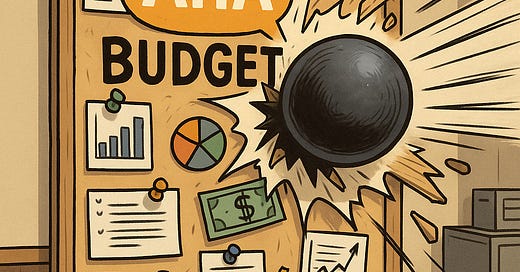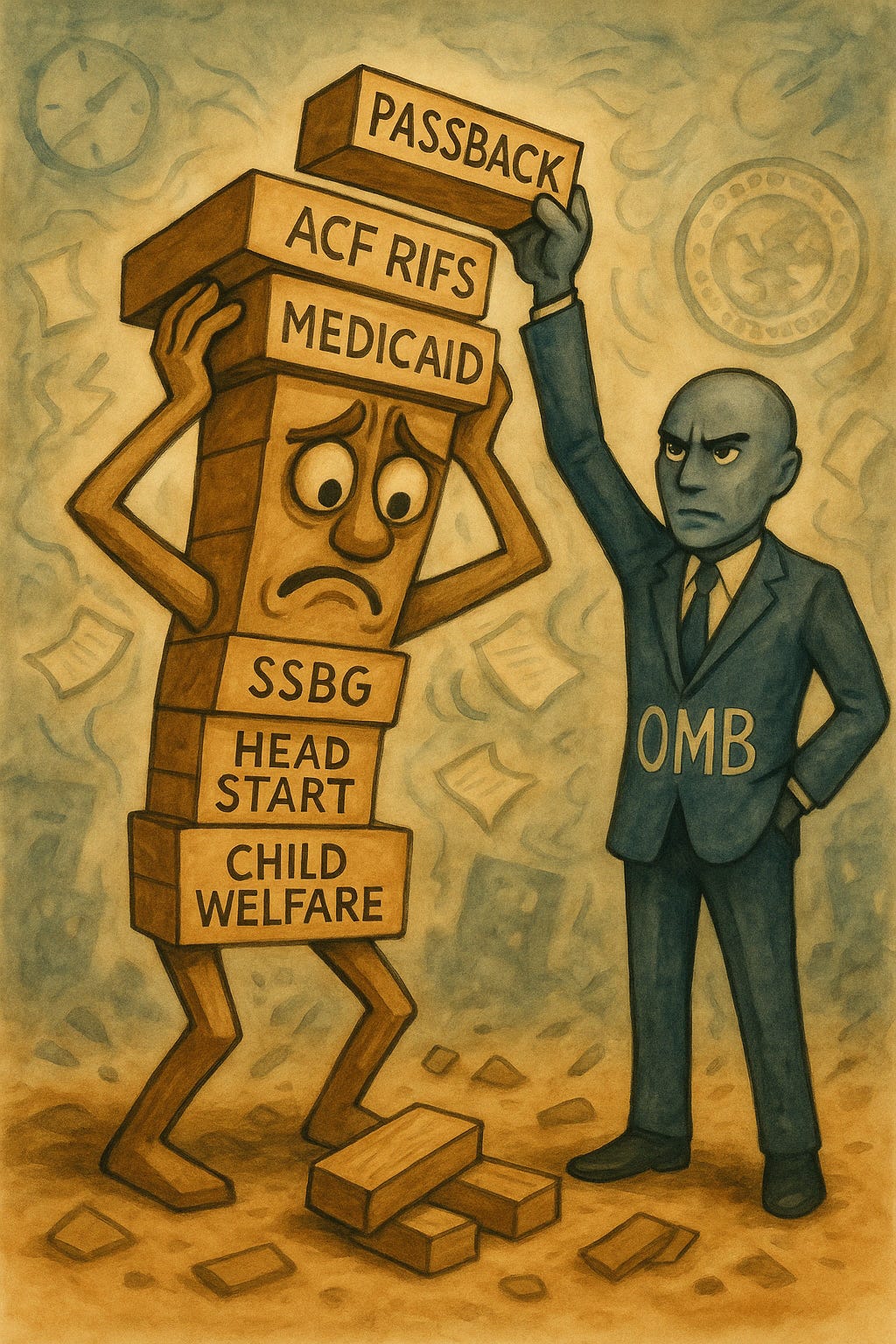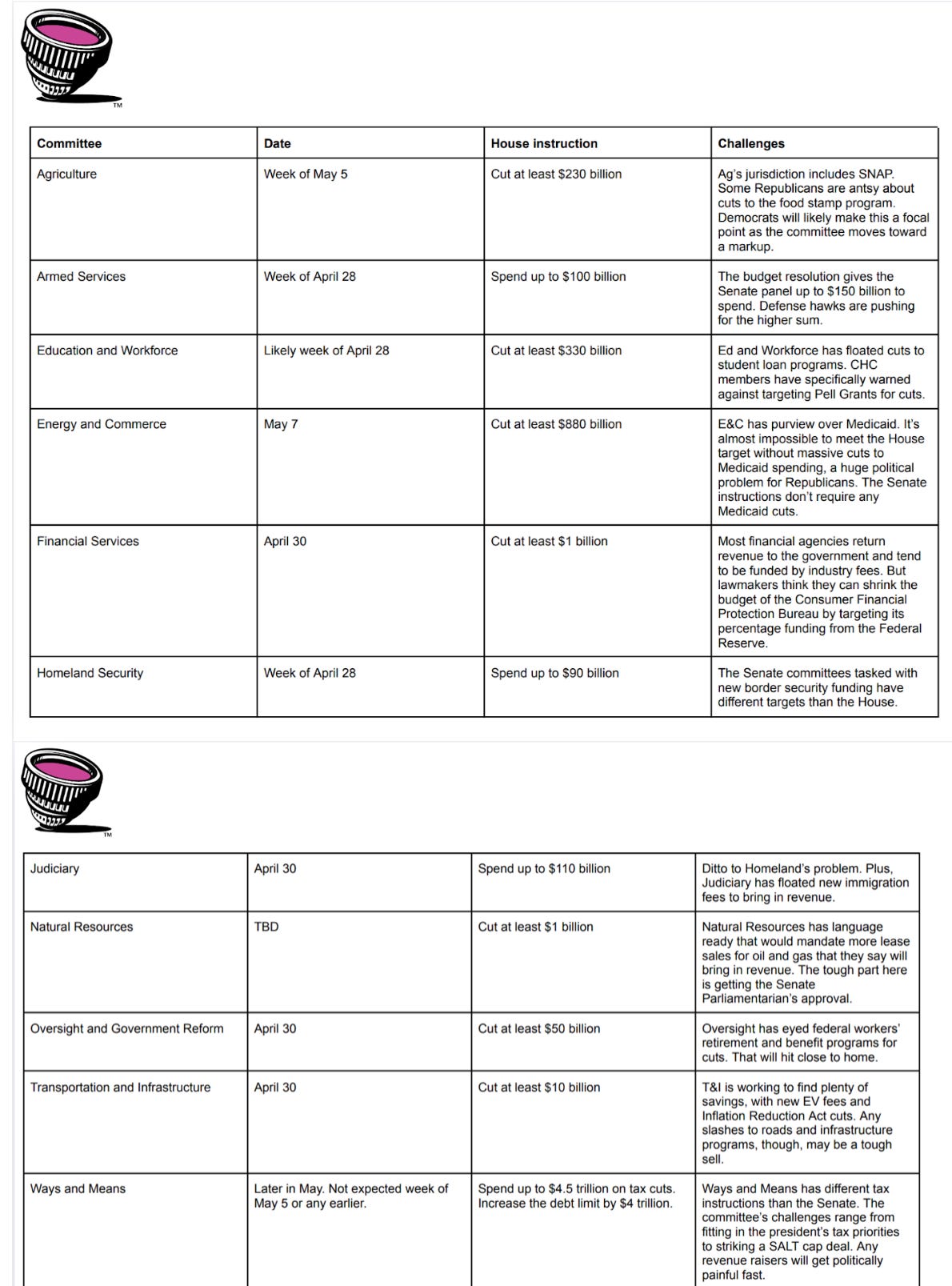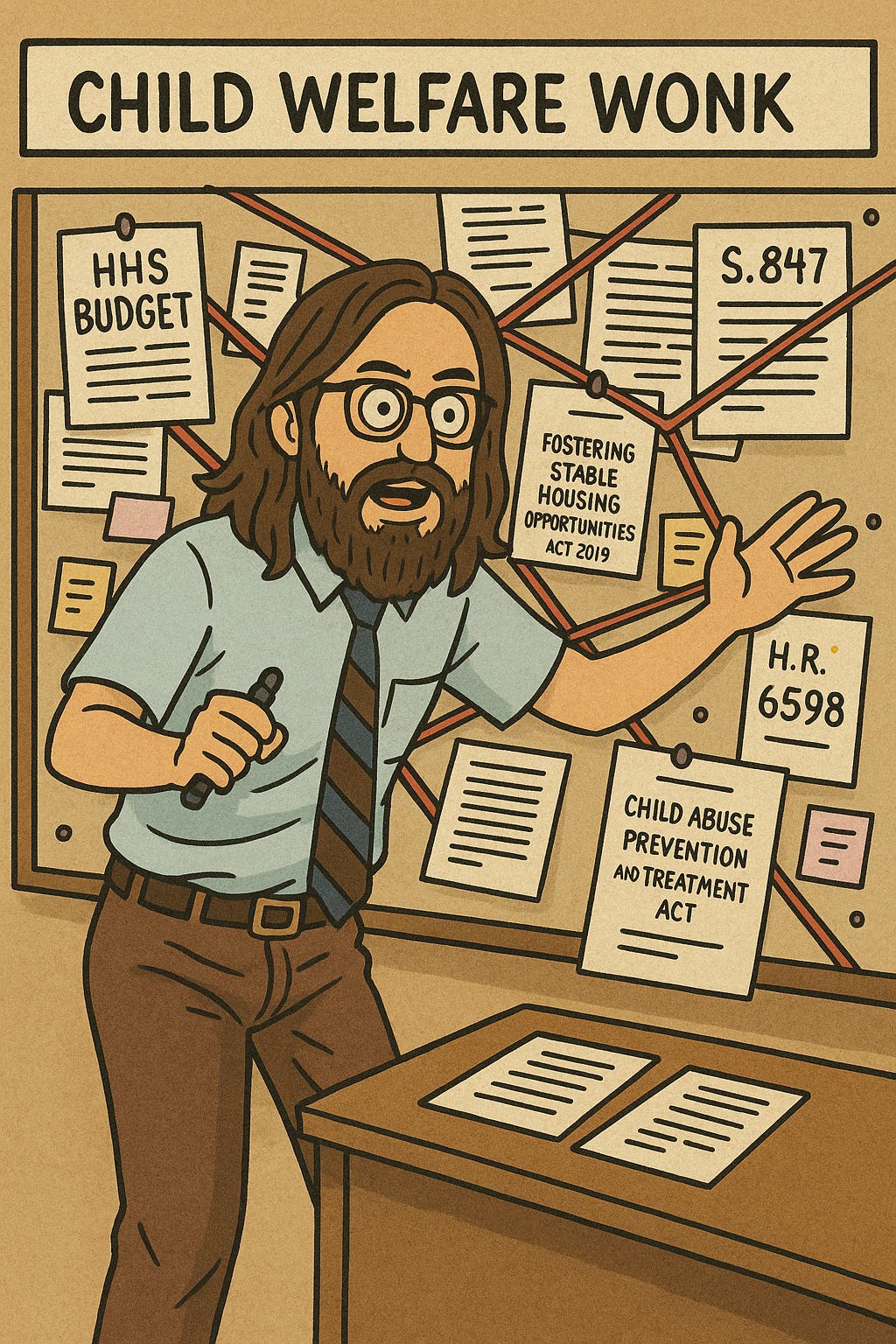Welcome, Wonks! Wishing a smooth re-entry for those returning from spring break.
Your Wonk This Week: We’ve got big budget news, more DOGE-driven changes at HHS, and reconciliation updates. Let’s get after it!
Wonkatizer: Brief Updates
Worth Reading: Santi Ruiz’s interview with Allegheny County’s Alex Jutca, on predictive analytics, parental substance use, data-driven policy, & risk in child welfare.
Rescission Season: The White House plans to send Congress a rescissions package this week, which would allow a fast-track vote to cut $9.3B in already allocated funds.
~$8B would come from foreign aid, leaving ~$1.3B from domestic spending. Congressional leaders hope to vote in early May, and we will have more as it evolves.
Child Welfare Jenga: Passback Style
Child Welfare Wonk doesn’t break the news; we find it broken and reassemble it for you with data, context, and humor.
You saw coverage of a leaked internal HHS budget document. What does it mean for child welfare and the Administration for Children and Families (ACF)?
This is where we can take you beyond the toplines of this story, to illuminate what this document even is, how to understand where it fits, and what it means for child welfare.
President’s Budget Request Overview: Context matters to avoid both over- and under-indexing to this document or the eventual FY26 President’s Budget Request.
The President’s budget request is a non-binding appropriations request to Congress. While non-binding, it’s a key policy priorities document.
Congress runs the appropriations process, and enacts funding legislation. So the budget request is an ingredient to inform it, not the core driver.
What a President’s Budget Request is (and isn’t): While aspirational, it’s less mood board and more opening salvo of negotiations in a multi-step process.
President’s Budget Request Process
The White House Office of Management and Budget (OMB) gives agencies budget guidance. Agencies draft and argue over what drives budget conflict in any org:
People. Staffing, compensation, and recognition;
Turf. Protection of individual or team priorities, projects, or resources; and
Politics. Substance (“we need this work”) & status (“I need more than my peers”).
Agencies send OMB their drafts for review, which then lead to a “passback” of notes for updates. Those updates roll into a final budget at OMB for release in two waves:
“Skinny Budget”. Short, with key highlights and vision.
President’s Budget Request. Long, with agency Congressional Justifications.1
What the Leaked Document is: This document is OMB’s passback to HHS. It’s an internal draft that will change, and it is NOT the actual decision on funding levels.
What’s in the Document: The OMB passback lays out a sweeping and ambitious plan to reorganize HHS. Here are overarching changes and child welfare implications.
Overarching Changes: The total discretionary HHS budget was ~$121bn in FY2024, which then received extension through FY25. This would reduce it to under $80bn.
Key changes would include:
Expanding the HHS reorg with a new $20B Administration for a Healthy America.
CDC would see a ~44% budget cut
NIH would receive a ~40% cut
Eliminating major programs relevant to child welfare, including:
Head Start (~$12B).
SAMHSA’s Pregnant and Postpartum Women SUD Treatment Program ($39B), which funds parent-child residential treatment.
ACL’s Developmental Disabilities and Advocacy Program ($45M), a proven mechanism for oversight on congregate care facilities.
Child Welfare Impact: Most federal child welfare funding is mandatory (e.g. IV-E, TANF, SSBG). Discretionary programs would be mostly level funded or face small cuts.
Title IV-B is mostly mandatory, but its discretionary child welfare services ($269M) would be level while Promoting Safe and Stable Families would drop $10M, to $63M.
CAPTA would see level funding for Title I state grant ($105M) and a $10M cut to Community-Based Child Abuse Prevention, to ~$61M.
Adoption Incentives ($75M) and Adoption Opportunities ($53M) would be level.
What it Means: Passback Jenga and Child Welfare in Context:
This budget is developing amidst major structural shifts reshaping not just ACF’s resources and staffing, but its strategic purpose; what it is, what it does, and why.
Imagine ACF as a Jenga tower; each move rearranges structure and raises risks.
Major staff reductions. Level funding with far fewer staff and less expertise.
Curtailing spending authority. Each week sees new limits on HHS spending.
Editing out. Restructuring lays groundwork for eliminating programs like SSBG.
Layer on top of this the ongoing budget reconciliation deliberations, and it’s clear that federal child welfare policy is undergoing a once-in-a-generation overhaul.
What matters for each piece is not a planned placement, but a stable foundation.
What Comes Next: The next public-facing document will be the FY26 President’s Budget Request and accompanying CJs. We will analyze that in detail when it comes!
DOGE Demands: “Defend the Spend”
DOGE is now requiring direct approval for HHS grant payments, and ACF is among the first impacted by the change.
What’s New: DOGE added approval rules and new data fields to HHS’ Payments Management Services, which handles disbursement of grant funds.
What Used to Happen: HHS disbursed funds over time, as grantees reported on progress and requested distributions through the portal. Civil servants signed off.
What’s New: Grantees must justify each transaction’s connection to Administration priorities. Political sign-off is required and DOGE will post publicly on DOGE.gov.
Why it Matters: Last year this system disbursed nearly $1T in federal funds. This is the plumbing for grants to nonprofits and state, local, and tribal governments.
Key Questions: At this early rollout stage, we don’t yet have answers to questions policymakers, state and local officials, and service providers will want, such as:
Is this legal? Congress’ policy directives are irrelevant if funds are subject to unilateral redirection. Paging the Impoundment Control Act (P.L. 93-344)…
How do grantees navigate being stuck in the middle? Grants follow rules from Congress and an Administration. What happens when those are at odds?
What’s the burden? What will be the staff time and economic impact of the new administrative burden of this additional and more granular reporting requirement?
What Comes Next: Delays are included in filings for litigation between Catholic Charities and the Administration. HHS directs inquiries to defendthespend@hhs.gov.
We can expect further litigation from impacted grantees, questions from jurisdictions to HHS and their Congressional delegations, and oversight interest from Congress.
Major Change for Policy Personnel
On April 23rd, the U.S. Office of Personnel Management (OPM) will publish a proposed rule in the Federal Register reshaping the civil service.
Reclassifying “career employees with important policy-determining, policy-making, policy-advocating, or confidential duties” will affect ~2% of feds (~50,000 people).
What Changes: Those employees will be easier to fire; they’ll serve at-will, losing protections from the Civil Service Reform Act of 1978 (P.L. 95-454).
How Does it Affect Child Welfare: Anyone who develops or oversees regulations, makes decisions about grants, or oversees federal programs could be implicated.
What Comes Next: The rule will be open for 30 days of public comments, then President Trump will issue an executive order to reclassify employees.
We will continue to monitor this for how it affects the child welfare policy workforce.
Take a Step Back: Changes in Context
The steady stream of news and details often obscure the big picture. You don’t need to be a Deadhead to grasp that we can see more clearly when we take a step back.
Three months into Trump 2.0, it’s a good moment to take that step back.
What’s Changed: Feeling whiplash? Here’s major ACF impacts we covered since Jan.:
January
February
March
April
WH directive to rapidly repeal regs if contrary recent SCOTUS decisions.
DOGE control of Grants.gov posting & HHS grant disbursements (see above)
The Broader Shifts These Changes Suggest:
Programs>Platform.
Child welfare policy is moving from a collection of programs to a centralized platform advancing a unified agenda.
Centralizing funding and regulatory decisions with political leadership is a major change. If it persists, it’ll look very different over future administrations.
Risk Rises & Devolves Downward.
Statutes haven’t changed; states and providers still must deliver.
With fewer federal staff, novel oversight, and funding uncertainty, jurisdictions and providers bear the brunt of rising risk; funding, legal, & impact for families.
Stability Becomes Change.
When everything is changing rapidly across health and human services policy, level funding or policy means something different.
It takes $1.24 today to match the purchasing power of $1 in March 2020.2 Every time policymakers punt and leave funds level, time erodes them.
What it Means: This is not a critique or endorsement of any of these changes, just an acknowledgement that they are significant and worth understanding and engaging.
Policy frameworks usually change in marginal ways for the same reasons you don’t often update your home’s wiring; the structure relies on it.
When rare structural policy changes do occur, a window briefly opens for thinking deeply about rewiring. How does it align with your core interests? How could it?
Two Key Things on Reconciliation
You’re probably tiring of our reconciliation updates and their “Dad-Who-Will-Totally-Turn-This-Car-Around” energy, but we have key updates for you.
Reconciliation Reminder: Our reconciliation overview and recent forecast of state-by-state effects of possible spending cuts in reconciliation remain relevant.
One New Thing: A group of 12 House Republicans sent a letter to leadership expressing concerns about cuts to Medicaid impacting beneficiaries and hospitals:
“However, we cannot and will not support a final reconciliation bill that includes any reduction in Medicaid coverage for vulnerable populations.”
Who Signed On: The letter is from 12 House Republicans from 8 states:
AZ: Juan Ciscomani
CA: David Valadao & Young Kim
CO: Jeff Hurd
NE: Don Bacon
NJ: Jeff Van Drew,
NY: Nicole Malliotakis, Nick LaLota, & Andrew Garbarino
PA: Rob Bresnahan
VA: Jen Kiggans & Rob Wittman
One More New Thing: Punchbowl News put out a schedule of upcoming House hearings related to reconciliation.
And that’s a wrap for today. Have a good week, Wonks!
Wonks know these are a treasure trove of information, including recent actual appropriations for each office or program in an agency, and the details of how the budget request compares on these specific line items.
For example, this is the most recent ACF CJ, from FY25.
Courtesy of U.S. Bureau of Labor Statistics







